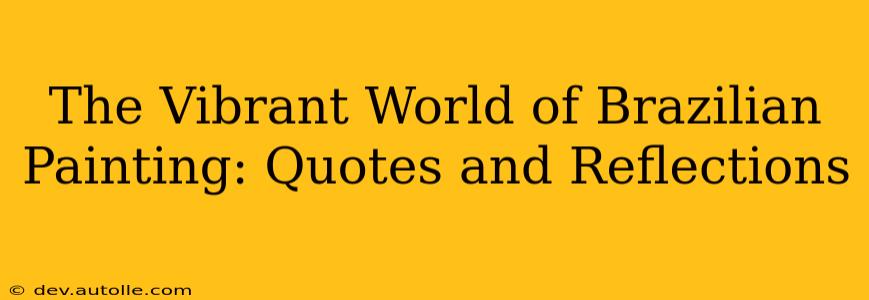The Vibrant World of Brazilian Painting: Quotes and Reflections
Brazil, a land of vibrant culture and breathtaking landscapes, has fostered a rich and diverse artistic tradition. Brazilian painting, in particular, reflects the country's complex history, its indigenous roots, its colonial past, and its modern dynamism. From the naive art of the early 20th century to the contemporary expressions of today, Brazilian artists have consistently challenged conventions and pushed the boundaries of artistic expression. This exploration delves into the heart of Brazilian painting, offering insights into its evolution, key figures, and enduring legacy.
What are the main characteristics of Brazilian painting?
Brazilian painting is characterized by its remarkable diversity, reflecting the country's multifaceted cultural heritage. Early works often depicted religious scenes in a European style, reflecting the colonial influence. However, as Brazil developed its own identity, artists began incorporating indigenous themes, incorporating elements of landscape, and developing unique styles. A strong sense of nationalism permeated much of 20th-century Brazilian art, with artists striving to capture the essence of Brazilian life and identity on canvas. This is evident in the use of bold colors, expressive brushstrokes, and a focus on local subjects, ranging from everyday life scenes to the lush landscapes of the Amazon rainforest. Modern and contemporary Brazilian painting continues this trend of experimentation and innovation, incorporating diverse influences and techniques while maintaining a distinctly Brazilian flavor. Think of the vibrant colors of Tarsila do Amaral or the social commentary embedded in the work of Candido Portinari—both hallmarks of a uniquely Brazilian artistic voice.
Who are some of the most important Brazilian painters?
Brazil boasts a pantheon of artistic giants. Tarsila do Amaral, a pivotal figure of the Modern Art movement in Brazil, is renowned for her vibrant depictions of Brazilian landscapes and folklore, embodying the nation's cultural identity. Her iconic works, such as "Abaporu," are instantly recognizable and continue to inspire. Candido Portinari, another master, is celebrated for his powerful social realism, depicting the lives and struggles of the Brazilian people with unflinching honesty. His murals and paintings offer a poignant commentary on social inequalities and the realities of rural life. Beyond these titans, numerous other artists have significantly contributed to the country's artistic landscape. Di Cavalcanti, with his stylized figures and bold colors, presents a unique vision of Brazilian urban life and Carnival. Emiliano Di Cavalcanti also stands out with his distinctive approach. The works of these and other artists, each with their own unique style and perspective, collectively paint a richer and more comprehensive picture of Brazil's artistic heritage.
What are some of the major movements in Brazilian painting?
Brazilian painting has been shaped by various artistic movements throughout its history. The early colonial period saw a strong European influence, primarily religious in nature. However, the 19th century witnessed the rise of Romanticism, with artists focusing on landscapes and national themes. The early 20th century saw the emergence of Modernism, notably championed by the Paulistas, who sought to define a distinctly Brazilian artistic identity. This movement, powerfully embodied by Tarsila do Amaral and her contemporaries, emphasized bold colors, simplified forms, and the incorporation of indigenous and folk themes. Subsequently, Social Realism gained prominence, as artists like Candido Portinari used their art to address social and political issues. Contemporary Brazilian painting is characterized by its remarkable diversity, encompassing various styles and approaches, reflecting the country's multicultural and dynamic society.
How has Brazilian painting evolved over time?
The evolution of Brazilian painting mirrors the nation's own historical trajectory. From the initial colonial period, heavily influenced by European aesthetics, the art progressively developed a distinct Brazilian identity. The 19th century saw a shift toward nationalistic themes, emphasizing the country's landscapes and people. The 20th century brought about a period of intense experimentation and innovation, with Modernism, Social Realism, and other movements influencing the artistic landscape. Contemporary Brazilian art is a vibrant tapestry woven from these historical threads, incorporating diverse influences while maintaining a strong connection to its roots. The evolution reflects a constant interplay between global artistic trends and the unique cultural context of Brazil, a dynamic process of self-discovery and artistic expression that continues to this day.
Where can I see examples of Brazilian painting?
Many museums and galleries throughout Brazil and internationally house significant collections of Brazilian art. The Museu de Arte de São Paulo (MASP) in São Paulo is a renowned institution with an extensive collection of Brazilian paintings, encompassing various periods and styles. The Museu Nacional de Belas Artes (MNBA) in Rio de Janeiro is another important repository of Brazilian art. Numerous smaller museums and galleries across the country also showcase the works of both established and emerging artists. Internationally, museums in major cities such as New York, London, and Paris regularly feature exhibitions of Brazilian art. Additionally, many online resources provide access to images and information on Brazilian paintings, allowing for virtual exploration of this rich artistic heritage.
This exploration only scratches the surface of the vibrant world of Brazilian painting. Its richness and depth are a testament to the country's complex history and the creative spirit of its people. Each brushstroke tells a story, contributing to a national narrative that is both compelling and uniquely Brazilian.

